Minimalist running shoes – or “barefoot” shoes – are all the rage right now. You can’t go anywhere without seeing runners in Vibram FiveFingers. But should you run in them all the time?
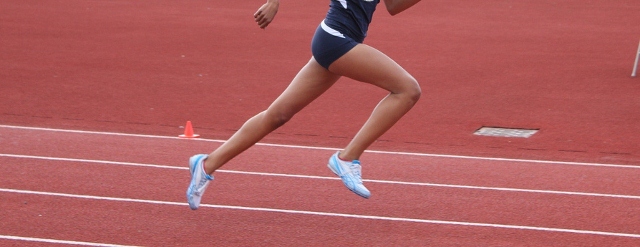
I think running exclusively in minimalist shoes isn’t ideal. They can help you develop lower leg and foot strength and reinforce a more efficient running stride, but they don’t provide enough support to be used on a daily basis.
Most runners didn’t grow up barefoot. The majority of us have to wear dress shoes or other more bulky shoes throughout the day. We simply do not have the lower leg strength that’s built up over years to support running in very minimalist trainers for every workout.
Instead, minimalist running should be used as a tool – just like a long run or hill workout. It’s one component of a good training program that works a specific area of your fitness. Just like your long run helps build your endurance, a pair of minimalist shoes (like Merrell running shoes) can promote better running form and foot strength.
Just like you wouldn’t do a hill workout every day, you shouldn’t train in minimalist shoes every day.
So What Exactly is a Minimalist Running Shoe?
Minimalist shoes have several characteristics. Not every shoe considered “minimalist” will be the same – in fact, there’s a huge variety of shoes on the market so it’s important to realize that there’s a spectrum of minimalism. Each shoe will have a combination of these:
- Lightweight – typically less than 9 ounces
- Wider toebox to allow your toes to splay
- Low heel-toe drop (the difference in height between the heel and forefoot area)
- Minimal cushioning, allowing you to run closer to the ground
- More flexibility / less support
On the far side of the minimalism spectrum you’ll have the infamous Brooks Beast – a 14 ounce motion-control shoe featuring a “Progressive Diagonal Rollbar” and a full-length “Bio MoGo midsole.” (WTF are those?) It promises a lot of technology, cushioning, and support for runners with low arches or flat feet and who over-pronate.
I don’t recommend this shoe for anyone.
The opposite side of the minimalism spectrum is running barefoot. The next level up is likely Vibram Fivefingers, a 4.4 ounce “shoe” with only a thin rubber sole and separate pockets for each toe. You don’t get any closer to being completely barefoot than with a pair of FiveFingers.
Minimalist shoes are on the VFF side of the spectrum – lighter, closer to the ground, more flexible, and less cushioned versions of more traditional running shoes. If you want to run in “less shoe,” read on!
How to Run in Less Shoe
You’re going to run a little differently in a much more minimalist shoe. With a lower heel and less cushioning, it’s easier to run with better running form (one of the reasons why it’s so beneficial to train occasionally in very light shoes).
There’s not a perfect way to run or a single form that beats all others. But there are a set of best practices that you should try to follow:
- Increase your cadence to about 170-180 steps per minute
- Land with your foot directly underneath your body
- Lean forward slightly from the ankles (not the waist)
- Your arms should be bent at about 90 degrees and swing from the shoulder in a straight line, not crossing the mid-line of your torso
- Your foot should land in a neutral, flat position on your midfoot. If you’re a slight heelstriker, that’s okay if your shoe has a little more cushion (even some elite runners are heel strikers)
- Look straight ahead (not at your feet) and focus on being relaxed
One of the best ways to improve your running form is to simply run a lot. By running frequently, your body will learn how to adopt the most efficient stride for you. So work on running more days per week and increasing your mileage safely.
This doesn’t mean I’m telling you to run more while in minimalist shoes. But as a general rule, runners who “run more” (it’s all relative) have better running economy and efficiency.
You might notice that it’s harder to run at your usual pace in minimalist running shoes. That’s totally normal – your muscles are working harder to absorb shock (instead of your shoes doing all the work)l so you’re using more energy to run the same pace. Just acknowledge that your pace is a little slower and don’t try to push your effort beyond what you know you’re capable of.
Always err on the side of caution and run a little too slow if you’re unsure how fast to run.
How to Transition to Minimalist Running Shoes
Your body will need time to adapt to the new stress of more minimalist running shoes. So remember that it’s a long-term process!
And it’s always a great idea to rotate through a variety of shoes:
And let me repeat: the goal should not be to run in less and less shoe until you’re barefoot. The goal is to wear minimalist shoes as a tool to help you develop a more economical stride and prevent injuries by increasing your lower leg and foot strength.
As you transition to a more minimalist shoe, remember these basic rules:
- Not everyone should try to run in the most minimalist pair of shoes they can find. Any runner who’s overweight, has very flat arches, or severe over-pronation should transition with caution. You may not want to run in lightweight trainers at all, but instead stick with foot strength exercises (more on that later).
- There are no short-cuts to running in less shoe. It’s a long-term process so if anybody says you can do it quickly, you know they’re lying. Safety should be your #1 priority.
- Most running shoes only last between 300 – 500 miles. How long yours last will depend on the type of shoe, the running surface you typically run on, your stride pattern, and how much you weigh. Lightweight shoes may last for fewer miles.
- Always alternate at least two pairs of shoes – alternating helps prevent injuries and allows you to wear one lightweight pair and a more traditional pair of shoes. It also prolongs the life of your shoes by allowing them to “rest” (they need recovery too!).
Now that the ground rules are set, let’s look at the specific steps you can follow to transition safely into a more minimalist pair of running shoes.
- Buy a more supportive pair of minimalist shoes. My top recommendations include the ASICS Speedstar or the Saucony Kinvara. Alternate shorter runs in this pair with longer runs in your more traditional pair of shoes.
- At least three times every week, strengthen your feet with two sets of these foot exercises: picking up marbles with your toes and rolling a small towel. They’re simple, fun, and effective.
- After 2-3 weeks of alternating short runs with your lightweight trainers and doing your foot exercises, run a weekly session of 2-4 barefoot strides after an easy run. It’s best to do these on an artificial turf or manicured field.
- About two weeks later you can increase the number of strides to 4-6 per session. After another two weeks, try running two sessions per week.
- Once you’re doing steps 1-4, you’re getting almost all the benefits of barefoot running! Stronger feet and lower legs, more running efficiency, but with a dramatically smaller injury risk.
- If you want to do more, replace your traditional running shoes with another pair of “more supportive” minimalist shoes.
You can continue in this pattern of replacing one pair of shoes with a slightly less supportive shoe until you’re running in the lightest and most flexible minimalist shoes you can find, like the FiveFingers. You could even consider doing a small amount of barefoot running at the end of your easy runs.
One of the most minimalist shoes on the market right now is the Merrell Trail Glove – a pair I was lucky to test the last few weeks. And now…a review!
Merrell Trail Glove Review
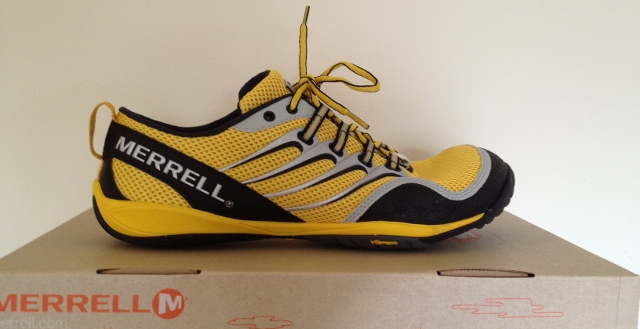
The good folks at RunningShoes.com (they sell running shoes – go figure!) provided a pair of shoes to test and review here. As is my usual policy, this is a 100% honest review with no preferential treatment. It doesn’t matter if I hated them or loved them.
The Merrell Trail Glove is an extremely lightweight, flexible, zero heel-toe drop trail running shoe. Before this, I had never run in shoes that had a neutral heel-toe drop besides track spikes. It’s a very unique experience and something that you have to get used to gradually over time. Runners who aren’t use to the heel being at the same level as the forefoot will put excessive strain on their achilles tendon, soleus, and calf muscles if they’re not careful.
I started wearing the Trail Glove casually with a pair of jeans. They’re not the best shoes for walking since you naturally heel strike when walking and they offer little cushioning. But after learning to walk a little more carefully, I gradually got used to them and now find them extremely comfortable. With a wide toe box and the ability to keep my foot in a neutral position, my feet are happy wearing them for short walks or doing errands.
You’ll notice from the side shot photos that the forefoot area bends up slightly when you’re not wearing them. I didn’t even notice this when walking or running in them. My thought is that they would ideally be 100% neutral – meaning they’d be totally flat. I’m not sure if this natural bend to the forefoot changes my foot position in the shoe, but it’s something to consider when making your purchase.
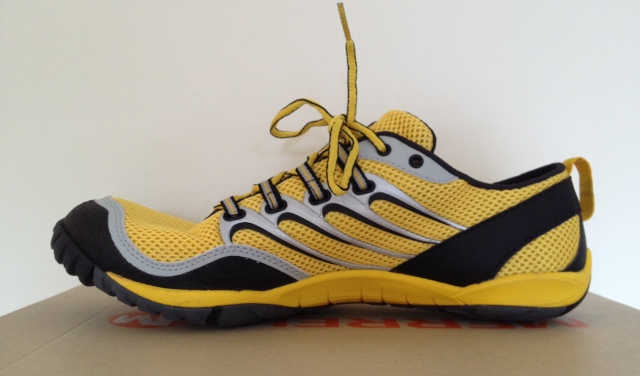
At this stage of my training, I’m not ready to go for long runs in an aggressive minimalist shoe like the Merrell Trail Glove. I wore them for a half-mile of an easy run and noticed the difference immediately. It’s almost impossible to heel strike in these shoes and since I’m a slight heel-striker, my form changed to accommodate the shoes.
With a more neutral landing, I felt more efficient. And it made me want to run a lot faster because it reminded me of wearing track spikes (but I didn’t, I know better). The tread on the bottom of the Merrell’s is designed for trail running so I could definitely see myself changing into these for a trail fartlek or tempo run once my lower leg strength is up.
Besides the zero heel-toe drop, the most significant difference between the Trail Glove and other shoes is the size of the toe box. It’s very roomy and even runners with wider feet should have no problem having enough room in the spacious toe area. The idea behind a wide toe box is to give your toes enough room to splay out, “grip” the ground, and avoid over-crowding or cramping your toes together.
You can get a great sense of the size of the toe box in the shot below. It’s wide.
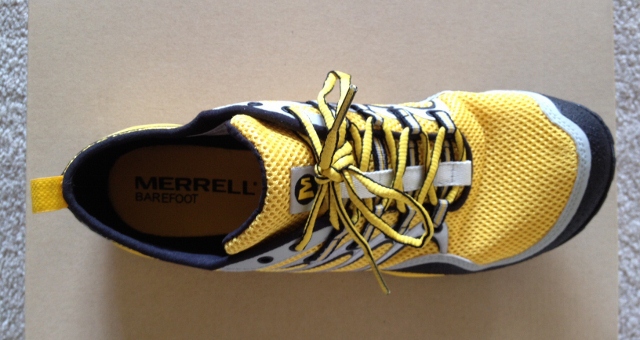
The tread on the bottom of the shoe is designed for trails and manufactured by Vibram. I take that as a sign of quality. I stay away from trail running shoes mostly because the tread is too aggressive for my tastes (and most of them are quite heavy) but the Merrell sole is just right.
I wore them on rocky trails and nothing got stuck in the tread. They also feel fine on pavement and smooth dirt surfaces, unlike a lot of other trail running shoes.
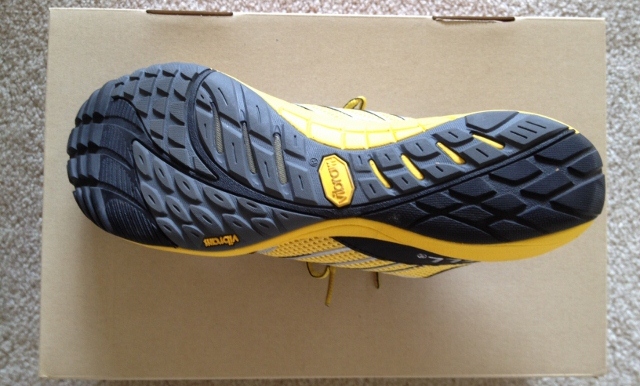
So do I recommend the Merrell Trail Glove? Only for advanced minimalist runners who are looking for a real barefoot shoe. These are super light at 6.2 ounces, have no difference in height between the heel and the forefoot, and will require a lot of getting used to.
If you haven’t transitioned away from your traditional trainers yet, I highly suggest starting with a more supportive pair of minimalist running shoes.
Thank you to RunningShoes.com for allowing me to review the Merrell Trail Glove! I hope that you run safe in your pair of minimalist shoes, transition gradually, and remember to always think long-term about becoming a barefoot runner if that’s your goal!